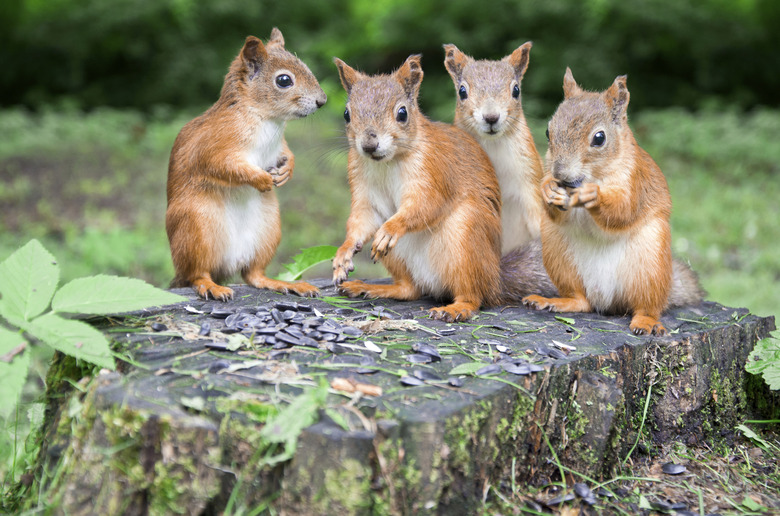How Do Squirrels Mate?
Squirrels, like many other mammals, engage in a process of courtship and mating that involves female mate choice. Squirrels are polygynandrous, meaning that both males and females may mate with several partners. Once mated, the female takes on sole responsibility for parental care of the offspring. In some species, the female will rear two litters per year.
TL;DR (Too Long; Didn't Read)
Both male and female squirrels mate with multiple partners. a number of male squirrels will chase a female in estrus within her territory until one finds her and mates with her. Males compete with each other by several means. These include attacking another male currently mating with the female, waiting somewhere within the female's territory to catch her before the other males do, guarding the female from other males, giving a call that sounds similar to the anti-predator call so that all of the other males hide and freeze, and forcefully removing the copulatory plug from a female's vagina after she has recently mated with another male.
The Mating Chase
The Mating Chase
When a female squirrel is approaching estrus (going into heat), male squirrels gather near her territory and wait for her to become receptive. If one of the males approaches and tries to mate with the female before she is ready, she will violently defend her territory against her pursuer.
Once she is ready, the female squirrel will run off and engage the males in a mating chase within her territory. Typically, the dominant male will find the female first and can mate with her, but not always. The female is in estrus for only a matter of hours, and the act of copulation takes from 1 to 25 minutes.
Male-Male Competition
Male-Male Competition
Male squirrels have adapted several strategies to help facilitate reproductive success. If a female has stopped the chase to mate, another male may attack the mating male viciously, occasionally injuring the female in the process.
Younger males may use a strategy in which they sit out the chase and wait within the female's territory, thus avoiding the risk of injury associated with chasing a female while there is a dominant male nearby. The dominance hierarchy of the males may vary geographically within the female's territory, so that the dominant male in one part of the territory may not be the same male that is dominant in other parts of the territory.
Mate Guarding
Mate Guarding
One reproductive strategy employed by some squirrel species, such as the Idaho ground squirrel, is mate guarding, whereby the dominant male stays in close proximity to the female and fends off any other males that try to approach her. A display of physical dominance is usually enough to keep competing males from attempting to reach the female, but the Formosan squirrel has adopted a different approach. Formosan squirrels emit a call after mating that is identical to that species' anti-predator call. This causes other squirrels to leave the area or become immobile to avoid detection. These post-copulation anti-predator mimic calls sometimes lasted up to 17 minutes.
Sperm Competition
Sperm Competition
Sperm competition can take many forms in animal societies where the female mates with multiple males, and may include the development of smaller sperm cells in greater numbers, the forceful removal of copulatory plugs – the coagulated sperm deposits left in females' vaginas by their mates – by subsequent males, mate guarding and other strategies to ensure insemination. Female tree squirrels sometimes manually remove the plug and either discard or consume it, thus enabling insemination by subsequent suitors.
Tactics like mate guarding and copulatory plugs suggest that the last male to mate with the female may have the reproductive advantage; however, female removal of copulatory plugs suggests that perhaps female squirrels have a different reproductive strategy that may include mixed paternity litters.
References
- College of Environmental Science and Forestry: Gray Squirrel
- National Institute of Health: Mate Guarding as Paternity Insurance in Idaho Ground Squirrels. Nature 338: 418-420.
- JSTOR: Mating System of a Territorial Tree Squirrel
- Springer Nature: Postcopulatory Mate Guarding by Vocalization in the Formosan Squirrel
- University of Arizona: Removal of Copulatory Plugs By Female Tree Squirrels
- Rodent Societies: An Ecological and Evolutionary Perspective
Cite This Article
MLA
Reid, Ari. "How Do Squirrels Mate?" sciencing.com, https://www.sciencing.com/squirrels-mate-4570892/. 25 April 2018.
APA
Reid, Ari. (2018, April 25). How Do Squirrels Mate?. sciencing.com. Retrieved from https://www.sciencing.com/squirrels-mate-4570892/
Chicago
Reid, Ari. How Do Squirrels Mate? last modified March 24, 2022. https://www.sciencing.com/squirrels-mate-4570892/
